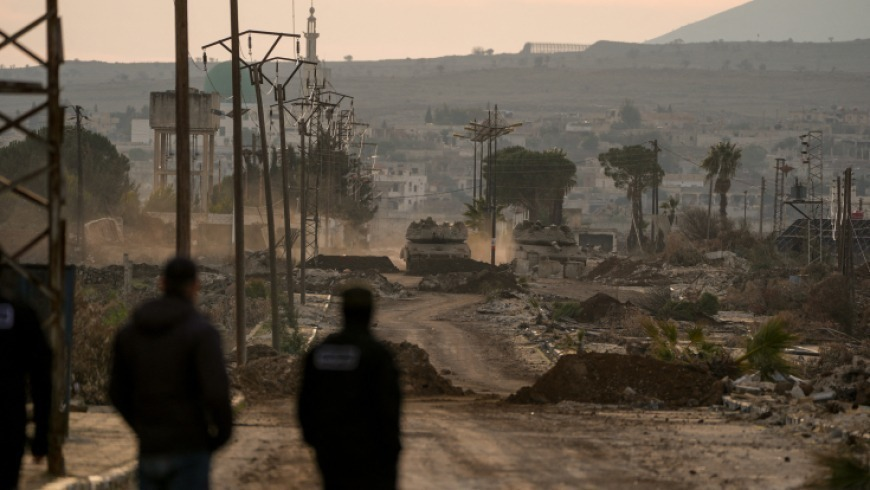
The investigation, based on field testimonies, satellite imagery, and internal communications, points to a chain of command that runs through the Ministry of Defense, with particular focus on its spokesperson, Hassan Abdel Ghani.
A new investigative report has uncovered the involvement of military factions affiliated with Syria’s Ministry of Defense in the killing of approximately 1,500 Alawite civilians across more than 40 locations in rural Latakia and Tartus during a three-day period in March 2025. The findings, published by Reuters, implicate at least 12 armed groups—half of which are under international sanctions for prior human rights violations—in a coordinated campaign of massacres that raises serious questions about command responsibility within Damascus.
The investigation, based on field testimonies, satellite imagery, and internal communications, points to a chain of command that runs through the Ministry of Defense, with particular focus on its spokesperson, Hassan Abdel Ghani. His name appeared in coordination messages on a Telegram channel used by the ministry to direct military movements during the attacks.
According to Reuters, the violence occurred between March 7 and 9, following a mutiny by former regime officers loyal to ousted president Bashar al-Assad that left around 200 security personnel dead. The response, according to the report, was swift and brutal—civilian homes looted, burned, and defaced with sectarian slurs such as “You used to be a minority, now you’re a rarity,” scrawled across village walls.
A Coordinated Military Operation
Reuters journalists visited multiple massacre sites and interviewed more than 200 relatives of victims, along with 40 security officials, fighters, and government-appointed investigators. They uncovered a pattern of killings that appeared systematic, with some fighters carrying pre-approved kill lists that included the names of individuals who had previously settled their status with the transitional government.
The massacres reportedly involved a wide range of groups:
State-backed units, including the “General Security Directorate,” “Unit 400” (formerly an elite division of Hayat Tahrir al-Sham), and “Liwa Othman,” were deployed to 10 sites where nearly 900 civilians were killed.
Pro-Turkish factions, such as the “Sultan Suleiman Shah Brigade” (known as the “Amshat”) and “Hamza Division,” were present in eight locations with around 700 fatalities.
Extremist factions, including “Jaish al-Islam,” “Jaish al-Ahrar,” and “Jaish al-Izza,” were involved in four sites where 350 people died.
Foreign fighters, from groups like the Turkistan Islamic Party and units of Uzbek and Chechen origin, were seen in towns such as Arzah and Banias, where an estimated 500 were killed.Despite the scale of the violence, the Syrian government has issued no formal response. The Ministry of Defense, the President’s Office, and the General Security Directorate all declined to comment when presented with a detailed summary of the investigation’s findings.
Mohammad al-Jassim (Abu Amsha), commander of the Amshat militia, denied involvement in the coastal attacks, claiming his forces never entered Jableh or Latakia.
Sectarian Violence and Civilian Terror
Among the most gruesome killings documented was that of Suleiman Rashid Saad, a 25-year-old Alawite man who was tortured and disemboweled. His heart was removed and placed on his chest. The attackers reportedly used his phone to call his father and challenge him to retrieve the mutilated body.
Witnesses recounted that fighters often began operations by asking, “Are you Sunni or Alawite?”—a chilling echo of sectarian purges. In villages like Rasafa and Sinoubar, entire families were massacred, children among them. Some were made to crawl and bark like dogs before being executed. Others were filmed by their killers, who circulated footage showing bloodied piles of corpses.
Community elders have compiled handwritten lists of victims, many of whom had previously cooperated with the transitional authorities. These accounts were corroborated by video evidence and surveillance footage analyzed by Reuters.
Political Fallout and International Silence
The revelations come at a politically sensitive time. President Ahmad al-Sharaa, a former HTS leader and Sunni Muslim, has led Syria’s transitional government since January after spearheading the campaign that toppled Assad. Though HTS was formally dissolved, many of its former units—including those implicated in the massacres—now operate under the umbrella of the Ministry of Defense.
The European Union, while denouncing the massacres “committed by all parties,” has not imposed sanctions on these former HTS-affiliated units. The United States, meanwhile, has remained silent on the killings, even as it gradually lifts sanctions imposed during Assad’s rule and encourages the integration of the Syrian Democratic Forces (SDF) into the new state apparatus.
The findings are deeply embarrassing for Washington, given that the transitional government was formed by a movement once designated as a terrorist organization with links to al-Qaeda.
A Fractured Society
The massacres have underscored the deep sectarian fissures that continue to plague Syrian society. Many Alawite areas remain deserted months after the attacks, their residents too fearful or traumatised to return. The systematic nature of the violence, combined with the government’s failure to respond or prosecute, has sparked fears of further fragmentation.
“Inside burned-out homes, in abandoned villages, the scars of March remain fresh,” one resident told Reuters. “No one is talking about justice. No one even says the names.”
The report concludes that killings targeting Alawites are ongoing and that without transparent justice mechanisms, the transitional phase may only reproduce the exclusion, violence, and symbolic marginalisation that defined the Assad years—but under new banners.
